The city of Chengdu has played an essential role in China's history for thousands of years. It is located in the province of Sichuan, one of the country's top rice and wheat growing regions. It was under the Qin and Han Dynasty of circa 316 BC that Chengdu became the political, economic, and cultural capital of southwest China, as well as a hub for its raising of silkworms and the making of brocade.
By the period of the Three Kingdoms from AD 220 to 280, Chengdu had been the capital of the state of Shu Han and, by the 8th century, it was an important hub of trade, commerce, and industry, known for its lacquered and silver filigree work. During the era of the Five Dynasties from AD 907 to 960, Emperor Meng Chang arranged for huge quantities of hibiscus trees to be planted around the town walls and streets, a custom that continues to this day and lends the city with its moniker, Hibiscus City (Rong Cheng).
These days, Chengdu is a major industrial town and is undergoing a great construction blitz. It's also a popular cultural and tourism attraction, and is home to 14 colleges, including Sichuan University, as well as several traditional teahouses and tea gardens. And considering the fact that, like most Chinese cities, Chengdu is a safe area for travelers, it's pleasant to explore at night, engaging in cultural events such as a Sichuan opera, and other interesting things to do such as dining and shopping.
This lively metropolis also acts as an excellent jumping-off point for day trips and explorations of the surrounding countryside. Find the greatest places to visit in and around the city with our list of the top attractions and interesting things to do in Chengdu.
1. Feed the Pandas at Chengdu Research Base of Giant Panda Breeding

The Chengdu Research Base of Giant Panda Breeding — sometimes shortened to Chengdu Panda Base — not only offers an opportunity to see these beautiful creatures up close in their natural surroundings, it also provides an in-depth look at one of the world's most-loved and laid-back animals.
Established in 1987, the institution began with just six rescued giant pandas, a figure that has now risen to 83 animals and seen some 124 panda births. Tours also give an opportunity to explore the on-site museum including exhibits dealing with the reproductive concerns of these fickle bears. Pandas are most active in the morning when they are eating, so you should time your visit accordingly. Pandas are commonly found sleeping.
Participating in an organized tour, such as the Half-Day Chengdu Panda Breeding Center Tour, is a fantastic way to get the most out of a visit and is highly recommended. If you can, be sure to select the enhanced baby panda holding option for an amazing, close-up experience of these intriguing — and lovable — critters. Transportation to and from the hotel is provided free of charge.
For an even more unique experience, try choosing the Panda Rescue Center Volunteer for a Day package. This one-of-a-kind experience gives you the opportunity to feed these adorable animals while also providing you with a private tour of the facility (we'll pick you up from your hotel and take you there, and lunch will be provided).
Plan a journey to the expansive Wolong Nature Reserve, which is located about 130 kilometers west of Chengdu. There, you will get the opportunity to witness pandas in their natural habitat. This magnificent conservation area encompasses a total land area of 2,000 square kilometers and is encircled by mountains. It is home to sixty distinct species of mammals, as well as three hundred various kinds of birds and four thousand different kinds of flora, some of which are enormous redwood trees. And then there are pandas, of course!
2. Plan a Visit to the Leshan Giant Buddha for the Day
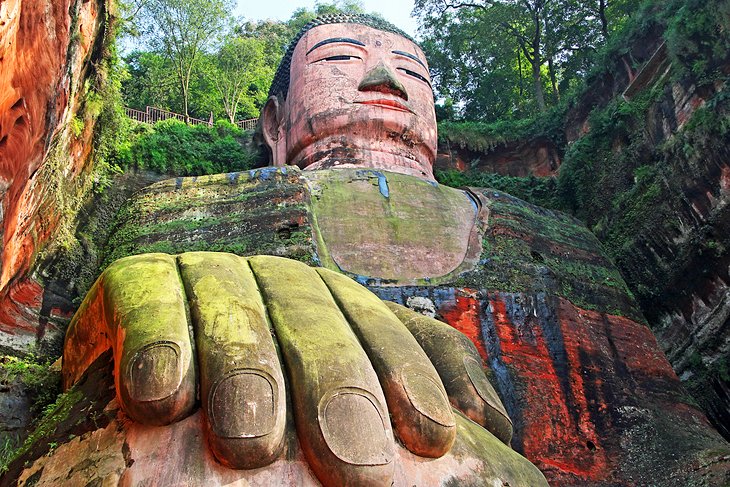
Since 1996, the enormous stone statue of Maitreya that is known as the Leshan Giant Buddha has been recognized as a UNESCO World Heritage Site. This incredible achievement, which is 71 meters in height and was hacked out of the rock that was all around it, was initiated in the year 713 AD by a Buddhist monk by the name of Haitong. After he passed away, the project was carried on by a number of other monks and artisans until it was finally finished in the year 803 AD.
The statue is now the largest Buddha sculpture that can be discovered anyplace in the world. As a result, it draws tourists and pilgrims from all over the world. In addition to this, it is the origin of the well-known proverb that states, "The mountain is a Buddha and the Buddha is a mountain."
One of the finest ways to enjoy a hassle-free trip is to take a private tour, such as the first-rate Day Trip to the Leshan Grand Buddha from Chengdu. Highlights of this popular day excursion include an English-speaking guide, who will accompany you to a few different viewing places from which to view the Buddha, including from an optional river cruise, if you so want. You will also have the opportunity to take a private tour of the Lingyun Temple and the Wuyou Temple. Included with your excursion are lunch at a traditional Chinese restaurant, as well as pickup and drop-off from your hotel in Chengdu.
3. Tour the Chengdu Wuhou Shrine
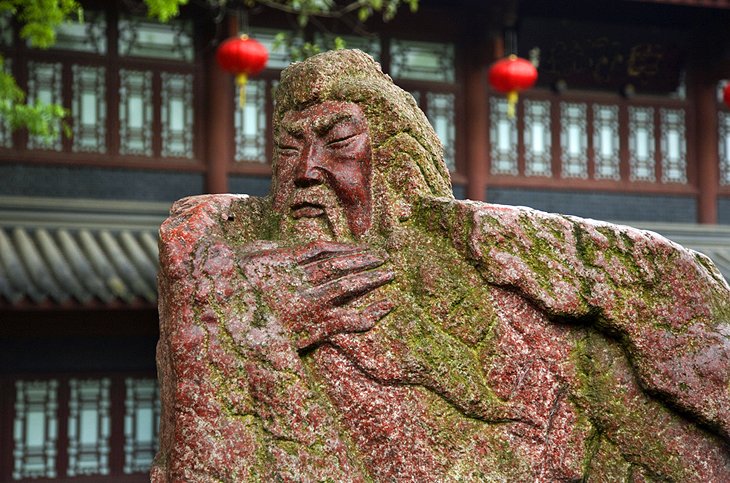
The magnificent Chengdu Wuhou Shrine is one of Chengdu's oldest temples. Its history can be traced all the way back to the year AD 302. It was constructed in his honor because Zhuge Liang was a well-known strategist and statesman who subsequently held the position of Chancellor of the Shu Han kingdom from AD 221 until AD 263. As a reward for his achievements, Liang was elevated to the position of prince.
This massive temple complex, which was rebuilt in 1672, is home to a number of fascinating attractions. The most remarkable aspects include its spacious central hall, which contains a clay statue of Zhuge Liang that has been gilded; the two smaller figurines on either side of the prince represent Zhuge Liang's son and grandson.
The nearby temple that is dedicated to Liu Bei, the king of the Shu Han Empire and the person who is buried in the neighboring burial mound that is 12 meters tall, is well worth visiting. There are also 28 terra-cotta statues of ministers, generals, and high officials from the state of Shu Han that are displayed in the east and west covered walks. These statues might be considered another important feature. There are also a handful of antique stone tablets that have been written on and include writings and poems from this significant time period in China's history.
related link: Stunning Black-sand Beaches, National Parks, and Dormant Volcanoes Can Be Found in This Spanish Archipelago
4. For more information, go to the Dujiangyan Irrigation System.
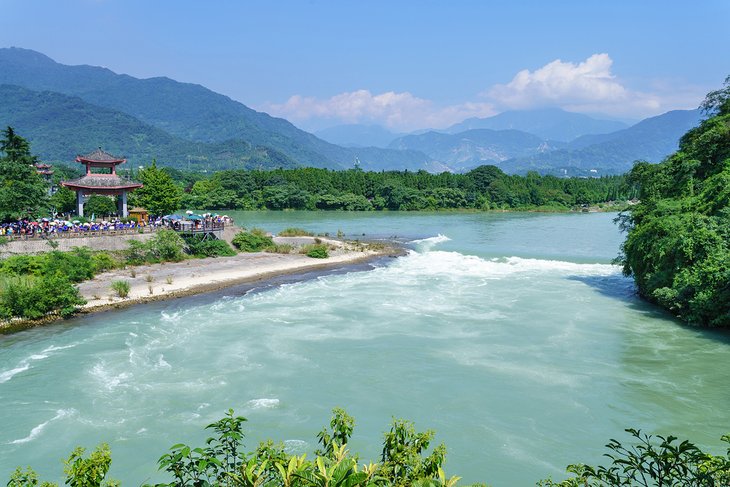
The intriguing Dujiangyan Irrigation System may be found close to the village of Guanxian, which is situated on the upper reaches of the Minjiang River. It was built about the year 250 BC. Even though it's about 55 kilometers to the northwest of Chengdu, it's still a gorgeous section of the country and definitely worth visiting as part of a day trip.
Constructed to avert catastrophic flooding, this extraordinary system includes a network of earth dams with parts branching out into streams and canals to irrigate areas. The system features curiously named components such as the Fish's Jaws, which works as a watershed and dike; the weir known as Flying Sands (Feisha Yan); and the canal, the Neck of the Precious Bottle (Baoping Kou). Because of this innovative structure, the Minjiang Valley has not been flooded in more than 2,200 years, and the Chengdu Plain in central Sichuan has developed into one of the most fertile places in China.
Cave of the Heavenly Master (Tianshi Dong) is a nearby attraction that is well worth a visit. This is the location where Zhang Daoling, the founder of the Taoist religion, preached in a cave on Mount Qingchengshan. The temple comes from the Sui period of AD 589 to 618 and includes a terra-cotta depiction of Zhang Daoling and three statues dating from AD 723 portraying Fuxi, Shengong, and Xianyuan, three monarchs claimed to have ruled in China in prehistoric times.
A terrific way to explore the Mount Qingchengsahn region while at the same time taking in the must-see irrigation system, along with a number of other local areas of interest, is the entertaining Qingcheng Mountain and Dujiangyan Irrigation System Day Trip from Chengdu. After departing your Chengdu hotel, you'll spend a full day touring some of the most breathtaking landscapes in the Sichuan region's Qingcheng Mountains, along with its numerous well-preserved temples.
Dujiangyan is, without a doubt, the most notable feature of the area. In addition to describing the workings and significance of this wonderful feat of engineering, your English-speaking guide will also introduce you to great traditional food during lunch.
5. Visit the Wenshu Monastery (Manjushri Monastery)

Covering an area of more than 12 acres, the Wenshu (Manjushri) Monastery comprises of five different temples built from wood and stone. The structure was built in 1691 on top of the ruins of an older monastery that dated back to the reign of the Southern Dynasties between AD 420 and 589.
Highlights include the Hall of Shuofa Tang with its 10 iron statues of Buddhist guardian gods from the Song period of AD 960-1279, as well as the more than 100 bronze sculptures of Buddhas and Buddhist saints from the Qing era between 1644 and 1911, and many more made from materials such as jade and wood. The site also houses countless other valuable cultural relics, including paintings and calligraphy by leading Chinese artists and writers. Be sure to also spend some time at the teahouse located on the premises, where you can have a traditional beverage.
6. Take a Side Trip to Mount Emei and its Temples
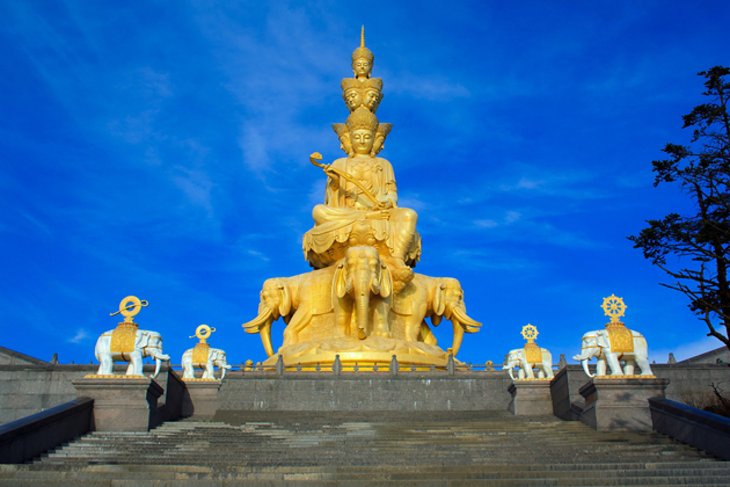
Mount Emei (Emeishan), devoted to the Bodhisattva Puxian, stands 160 kilometers southwest of Chengdu and is well worth a visit. The mountain's highest peak, the Peak of the Ten Thousand Buddhas (Wanfo Ding), reaches a height of 3,099 meters and is revered by Chinese Buddhists as one of the four Holy Mountains, the others being Mount Wutaishan in Shanxi province, Mount Jiuhuashan in Anhui province, and Mount Putuoshan in Zhejiang province.
As veiled in legends and myths as they are in clouds and mists, the first Taoist temples on Mount Emei were built during the Eastern Han dynasty between 25-220. Because it is home to more than 200 temples and shrines, it started being a popular destination for Buddhist pilgrims during the Tang Dynasty (618-907 AD), when it was still a part of China. There are approximately 20 monasteries and temples that have been preserved.
7. Pay a Visit to the Home of the Poet, the Thatched Cottage of Du Fu
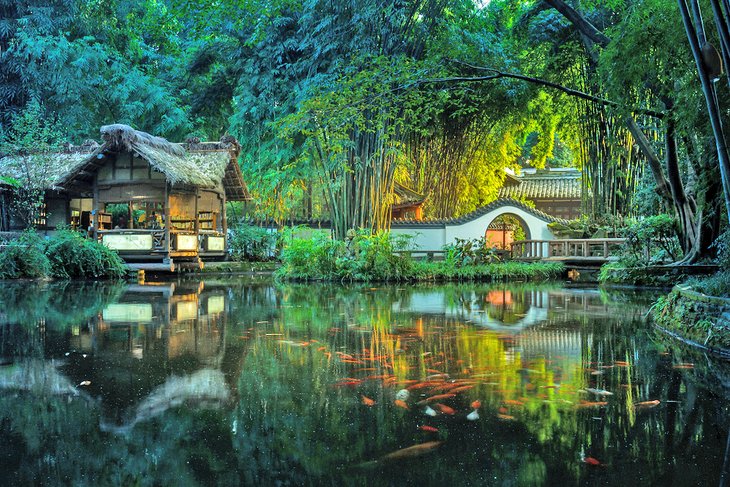
The huge Du Fu Thatched Cottage complex in Chengdu, also known as Dù Fu Cao Táng, is devoted to one of the most well-known poets to come out of China. The complex comprises 24 acres. The mansion in which Du Fu resided from AD 759 until AD 763 and in which he penned more than 250 of his most famous poems has been meticulously recreated at this location.
The complex is located on a gorgeous bend of the Huanhuaxi River, and it has lush gardens, multiple pavilions, as well as lovely bridges and walks across its grounds. Although not all of the buildings are old, the most of them date from about 1500 and 1800 and underwent meticulous restoration in 1949. Other noteworthy features include the Gong Bu Memorial Hall, which showcases exhibitions about the life and work of Du Fu and includes a section devoted to translation into foreign languages.
It is also possible to tour the recreated cottage itself, which is a straightforward building that contains a kitchen, a bedroom, and a study. The Hall of Great Poets, which depicts scenes from some of his most well-known poems, including one that is dedicated to the poem's subject matter of a storm destroying the original home, can also be seen.
8:River Watching Tower in the Wangjiang Pavilion Park
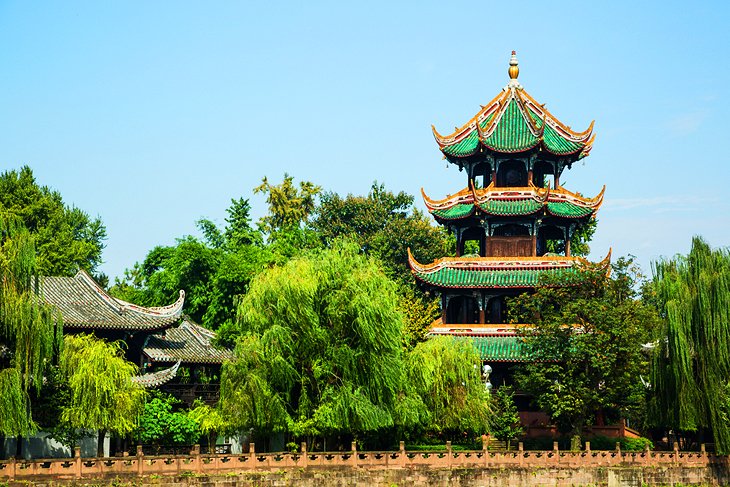
In addition to being well-known as the residence of the poetess Xue Tao during the years AD 769-834, Wangjiang Pavilion Park is renowned for the magnificent River Watching Tower that stands at a height of 30 meters. It is reported that the poetess used water from the renowned old fountain during the Tang period of AD 618-907 in order to produce the one-of-a-kind red paper on which she wrote, which to this day still retains her name. The attraction was constructed in 1889, and it features the famous old fountain. The Tang dynasty lasted from AD 618-907.
Other noteworthy structures include the Tower of Poetic Recitation (Yinshi Lou), the Pavilion of the Washing of Paper (Wanjian Ting), and the Tower of the Washing of Brocade (Zhou Lou). Each of these structures was constructed in her honor and is now dedicated to her memory. An extensive bamboo grove that was planted in her honor is yet another beautiful element of the space. The poetess regarded bamboo as one of her most beloved tree species, and this location is home to a staggering 140 different types of the plant.
9. The Mausoleum and Museum of the Yongling Family
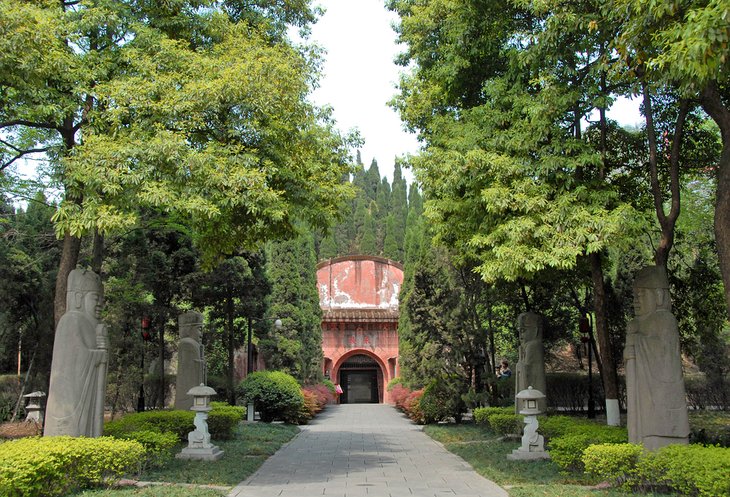
Also referred to as the Eternal Mausoleum, the Yongling Mausoleum is where you'll find the well-preserved royal tomb of Wang Jian, king of the Early Shu Empire until his death in AD 918. Located in the northwest portion of Chengdu and now a museum, this stunning 15-meter-high edifice with its 14 impressive archways opened to the public in 1942 and is divided into three chambers, the central of which houses the emperor's exquisitely painted sarcophagus.
A magnificent stone statue of Wang Jian and intricate paintings of 24 musicians carved from stone are also attractions of a visit. These are the only such decorations of their sort that date back to the Tang Dynasty.
10. Chengdu Culture Park and the Sichuan Opera
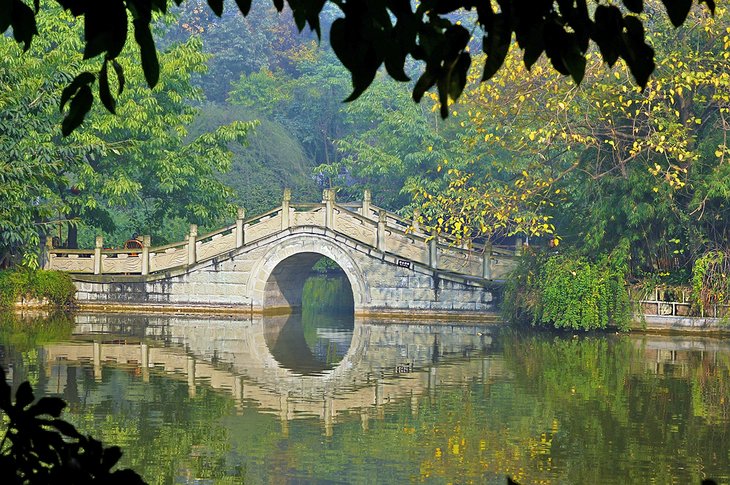
The historic Taoist Qingyang Temple may be found in Chengdu's Cultural Park (Wenhua Gongyuan), which is located in the western portion of the city. Although they date back to the Tang dynasty, which lasted from AD 618 to 907, the present buildings date from the Qing dynasty, which lasted from 1644 to 1911. The Pavilion of the Eight Trigrams (Bagua Ting) is a particular feature because of its eight stone pillars and elaborate carvings of dragons and other motifs from Chinese culture.
In addition, the Shufeng Sichuan Opera House can be found within the park's grounds. It is one of the most significant cultural sites in the city and plays host to a large number of performances of traditional Chinese music and drama on a daily basis. It is here that you will get the opportunity to witness the world-famous "Bian Lian," in which actors in brilliantly colored masks give the illusion of undergoing "face-changing" as they switch masks with varied expressions as fluidly as they flick a traditional Chinese fan. Amazing!
People's Park, which is the city's oldest public park and is known for its numerous significant monuments, is another park that is well worth a visit. The historic Railway Protection Movement Monument is the one that is the most well-known.
11. The Temple of Baoguang, Known as the Monastery of Precious Light
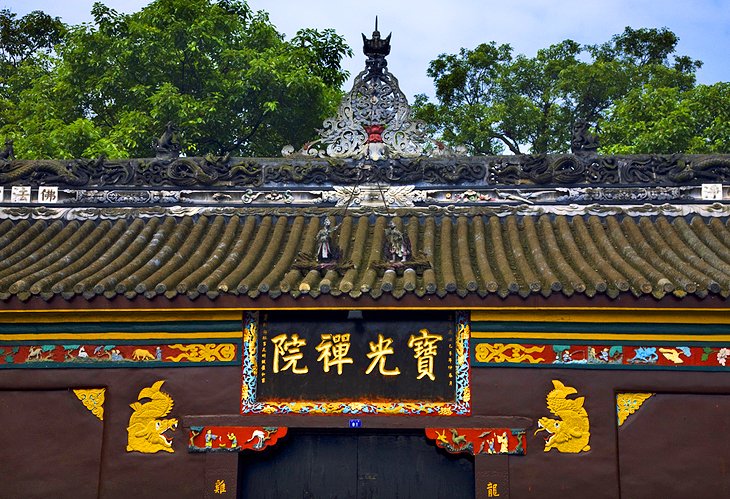
The Monastery of Precious Light (Baoguang Si) can be found in the little town of Xindu, which is located about 18 kilometers northeast of Chengdu. It is well worth taking the time to pay this monastery a visit. This enormous complex is believed to date back to the Han Dynasty, which lasted from AD 24-220 and consisted of more than 20 well-preserved buildings that were completed around 1670. These buildings include a beautiful pagoda, five temples, and 16 courtyards that are spread across an area of approximately 20 acres.
The 13-story Sarira Pagoda, which has been preserved in its original form since the Tang Dynasty (618-907), is perhaps the most spectacular structure of them. A stone tablet dating back to AD 540 and containing 1,000 Buddha reliefs is one of the centerpieces of the archaeological exhibitions. Another feature is a collection of 500 terra-cotta figures that are larger than life and are from the Qing period (1644-1911).
12. Take the scenic route through the Jianmen Pass.
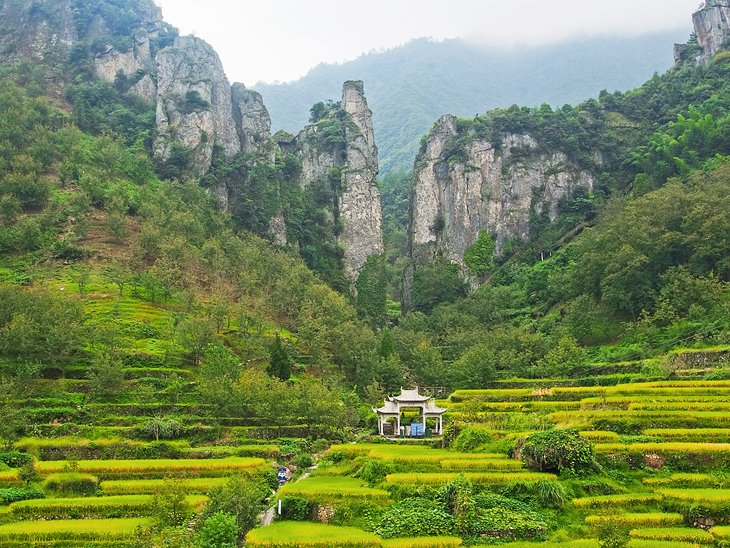
The Jianmen Scenic Route is frequently included in the itineraries of organized tour groups since it can be reached from Chengdu by the Shudao, a historic road that runs through Sichuan. It is definitely worth the visit for people who are traveling alone or in smaller groups via professional tours that depart regularly from the city, despite the fact that the round trip distance is greater than 300 kilometers.
This picturesque path takes in the stunning Jianmen Pass (Jianmen Guan). Known as the "Sword Gate Pass" in English, it's known for its steep slopes surrounded by some 72 peaks, as well as several important historical and cultural monuments. These include the Old Plank Road, the Thousand-Buddha Cliff, Mount Douchui, and Huangze Temple. The restored gate itself is the primary attraction, since it is an outstanding reproduction of the old structure that served to guard the route during the Ming Dynasty and for many centuries afterward.
13. Plan an excursion to the Mengdingshan Tea Plantation for the Day
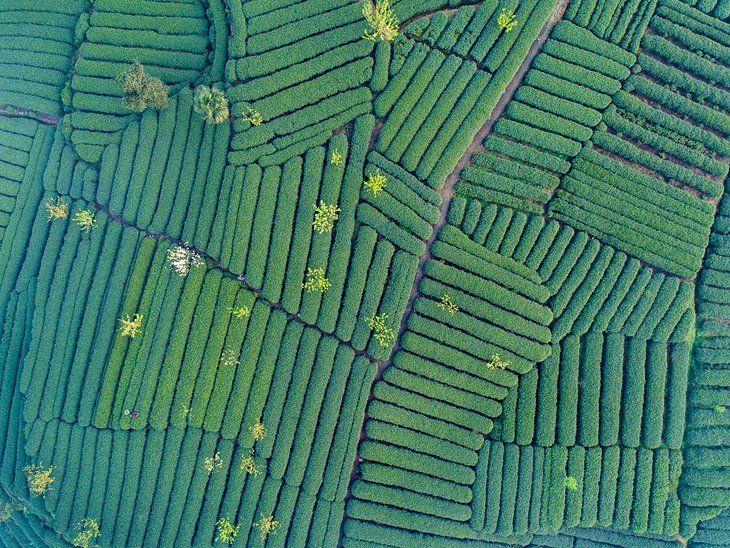
Due to the fact that tea is such a well-liked beverage not only in China but also throughout the rest of the world, no vacation to Chengdu is ever considered to be complete without at least one excursion to a real tea plantation. Mengdingshan, which can be reached within a day's journey from the city and is home to one of the nation's earliest tea plantations, is located just two hours' drive away.
A trip to a tea plantation not only allows guests to take in the breathtaking vistas, but also gives them the opportunity to gain knowledge about the various varieties of tea and the role that tea plays in the customs and traditions of China.
Discover fascinating, unusual, and adventurous things to do with our list of The 10 Most Popular Tourist Destinations in China.#Shanghai#Hangzhou#Chengdu#Guilin#Huangshan#Beijing#XiAn#SuZhou#Lhasa#HongKong pic.twitter.com/3NzYtWDKpa
— Fetch Book (@fetch_book) April 8, 2023
An organized group tour, such as a private Tea-Making Tour of Mengdingshan Tea Plantation, is a wonderful way to gain a first-hand understanding of the region's profound relationship to tea. This can be done in a number of different ways. This full-day excursion includes pickup (and drop-off) from your hotel in Chengdu, as well as the opportunity to meet a local farmer who will reveal specifics of the tea-growing process, as well as the history of the country's old tea-making rituals (an English-speaking guide is given). In addition, you will have the opportunity to sample some of the region's finest teas. Other highlights include the opportunity to enjoy a traditional lunch at an authentic local Chinese restaurant and to sample the tea that is produced in the region. Both of these activities are located in the region.
14. Take a stroll around some of the historic alleys of Chengdu, including Kuan, Zhai, and Jing Xiangzi.
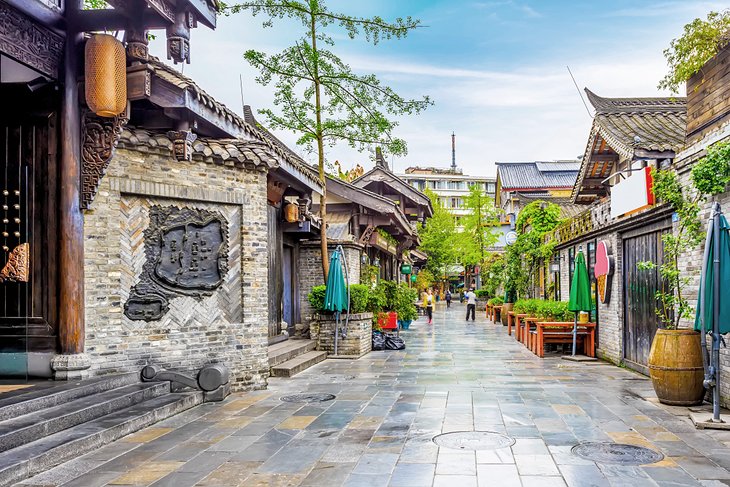
One of the things that is quickly becoming one of the most popular things to do in Chengdu is to investigate the three historic alleyways that are located in the city's old neighborhoods. These pedestrian-only lanes are a delight to stroll since they are both tiny and empty of traffic. As a result, they provide a fair feeling of what the city would have been like prior to the advent of industrialisation and the automobile.
In point of fact, the Kuan Xiangzi (Wide Alley) and Zhai Xiangzi (Narrow Alley) are the two alleyways that can trace their history all the way back to the Quing Dynasty of the 17th century, when the area was utilized to house troops. These alleys go by the names "Wide Alley" and "Narrow Alley." Today, these two alleyways, in addition to the more contemporary Jing Xiangzi (Well Alley), have both been totally restored to their former splendour in order to exhibit and preserve the city's rich historical and cultural heritage.
You will be exposed to over 20 gorgeous courtyards, many of which are now comfortable public areas where you can sit and relax while having a meal or beverage (make sure to try a traditional teahouse during your stay). In addition to the many traditional stores, workshops, and restaurants that line the alleys, you will also be exposed to these lovely courtyards. The region is also home to a number of significant places of worship, the most notable of which are the Wenshu Monastery and the Daci Temple.
15. Travel to Huanglongxi Ancient Town by Taking the Bus.
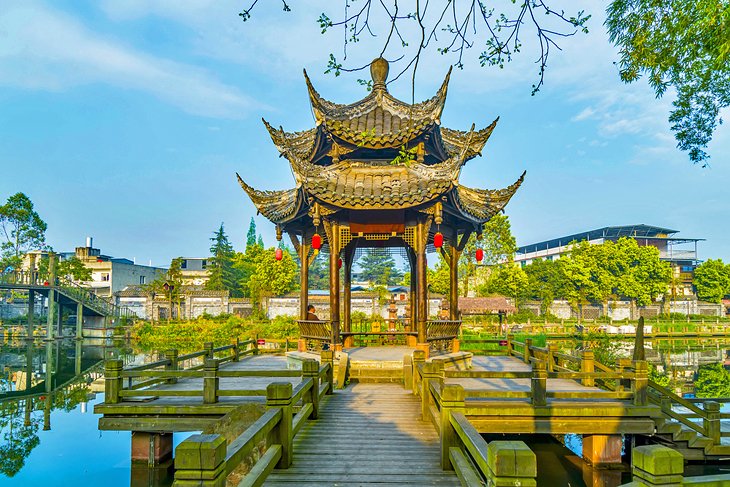
An additional fantastic opportunity to get a feel for traditional China can be had by taking a day excursion to the Huanglongxi Ancient Town, which is located only an hour outside of Chengdu. This well-known tourist destination provides visitors with a one-of-a-kind opportunity to experience life in China as it once was. Some of the features of this destination include magnificently maintained architecture that dates back to the Ming era in the 14th century.
Other attractions include the opportunity to tour several fine temples from this era as well as the later Qing dynasty, as well as a stunning covered bridge and a watermill that is still in operation. You will also be able to enjoy a scenic riverbank stroll that is reserved exclusively for foot traffic, in addition to seeing a plethora of traditional shops, artisan studios, restaurants, and teashops along the way. In addition, the region is home to two additional important historic villages, namely Luodai Ancient Town and Jiezi Ancient Town, both of which provide experiences that are analogous to that of the other.
There is the option to take a guided tour if you do not feel confident enough to do this on your own (you can get there via public transportation or taxis). The Chengdu to Huanglongxi Ancient Town private trip is one of the greatest, and it is also one of the most popular tours since it gives travelers the chance to explore some of the beautiful countryside that surrounds the city.
This full-day excursion includes a visit to a traditional Chinese market as well as an enjoyable climb to Chen Jia Xiang, a picturesque town that offers a look into traditional rural lifestyles that have, for the most part, remained practically untouched for centuries. at addition to that, you will be provided with a traditional meal served at the farmhouse using only regionally sourced products. In addition to the excellent value that this tour provides, other highlights include complimentary refreshments in a traditional teahouse, an English-speaking guide, and complimentary pickup and drop-off service at your accommodation.
16. Qingyang Palace
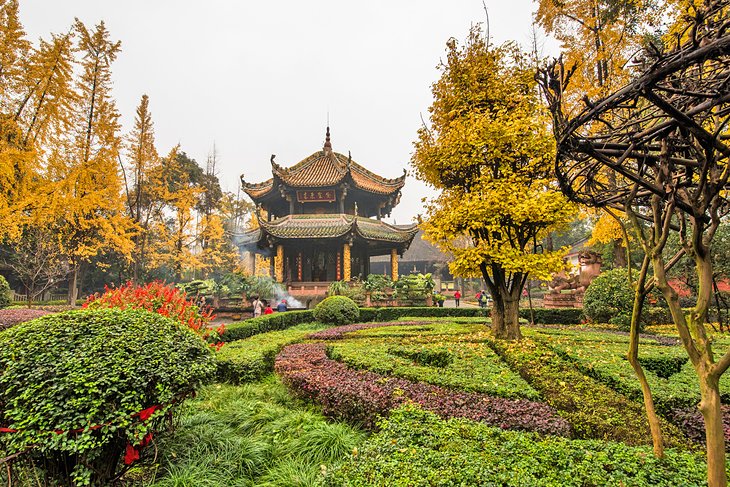
It is highly recommended that you spend some time exploring the Qingyang Monastery, also known as the Qing Yang Gong (Qingyang Palace). It is a short distance away from the Wenshu Monastery, which was previously described. During the Tang Dynasty in the seventh century, construction began on a component of this historic site that is now regarded as one of the most significant Taoist temples in China. Subsequent centuries saw the construction or restoration of other sections of the temple.
Be sure to make a bee-line for the spectacular Eight Trigrams Pavilion, the site's most noteworthy structure and notable for its octagonal shape, enormous glazed dome, and dragon-emblazoned supports. In addition, this location is noteworthy for its extensive collection of significant Taoist relics as well as its world-famous bronze goats, which were carried all the way from Beijing. If time allows, be sure to enjoy in a calming beverage at the on-site teahouse.
17. Huangcheng Mosque
One of China's most important Muslim sites, the Huangcheng Mosque dates back to the 18th century and lies in the center of the city's old Xicheng District. Although severely damaged by a Japanese air strike in 1941, the site stands out for its mix of traditional Chinese and Arabic-influenced architecture, with its white walls and colorful flourishes. It's most prominent feature is its enormous 16-meter-long prayer hall covered in original tiles.
An further attraction is a library that has many block-printed Korans written in both Arabic and Chinese. The lovely central courtyard also is a highlight, as are the two gates that lead into it. Find the beam that has a plaque affixed to it that says "Seventh year of the empire of Qianlong" (the answer is 1742) in order to determine the precise year in which the structure was erected.
18. The Bridge of Anshun
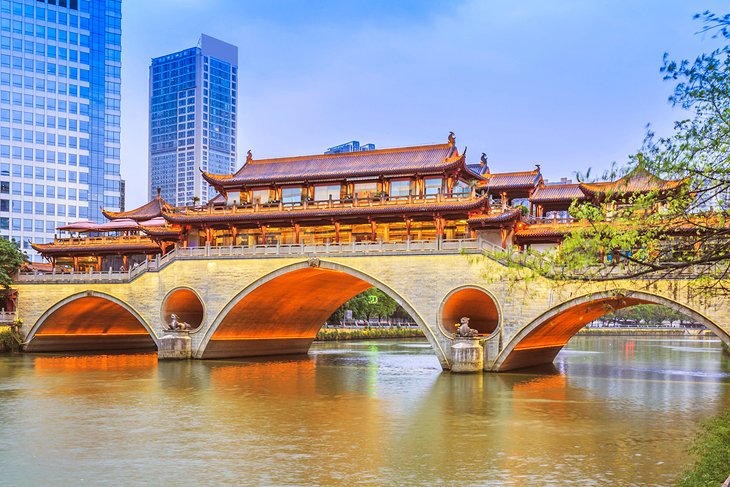
There is no question that the Anshun Bridge, which spans the Jin River in Chengdu, is without a doubt one of the city's most visually appealing structures. This faithful duplicate, which dates back to 2003 but was modeled after the one that was built in 1746 and was destroyed by a severe flood in 1947, is a delight to look at. The original structure was erected in 1746.
At night, when it and the metropolis around it are illuminated, it is highly popular as a tourist destination. In addition to serving as a convenient pedestrian crossing over this expansive river, the bridge is also home to one of the city's most popular restaurants (the sights that can be enjoyed while dining are well worth the effort of making the effort to stop and take in them).
19. Sichuan Science & Technology Museum
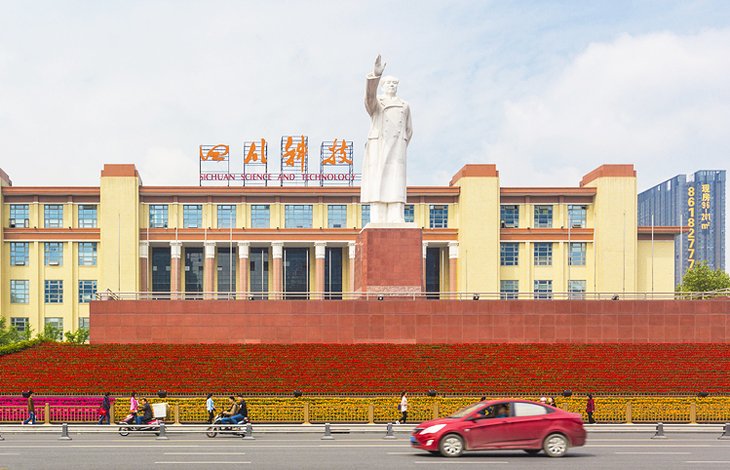
Although housed in a fairly austere looking building, the Sichuan Science and Technology Museum is well worth a visit for those with an interest in..., well, science and technology, but with a distinct Chinese spin. And at an astonishing 60,000 square meters split over five levels, it's a massive attraction, so be prepared to walk a lot.
You'll be rewarded with a chance to experience over 600 exhibitions dealing with issues as diverse as ancient farming techniques and land management, right up to China's involvement in the space race, robotics, and airplanes. Be sure to check out the display concentrating on the country's famous Dujiangyan Irrigation System. This functioning model provides a good glimpse into the attraction before (or after) you see it in person.
Also worth seeing is the Sichuan Museum. A similarly enormous affair, it has various interesting exhibitions of antique pottery and Buddhist art acquired from around the region. And if time allows, gourmands and foodies should go inside the Sichuan Cuisine Museum of Chengdu. Highlights include informative displays and exhibits connected to the famed Sichuan style of cuisine, along with the ability to develop your abilities by participating in a fun cooking lesson.
20. West Pearl Tower
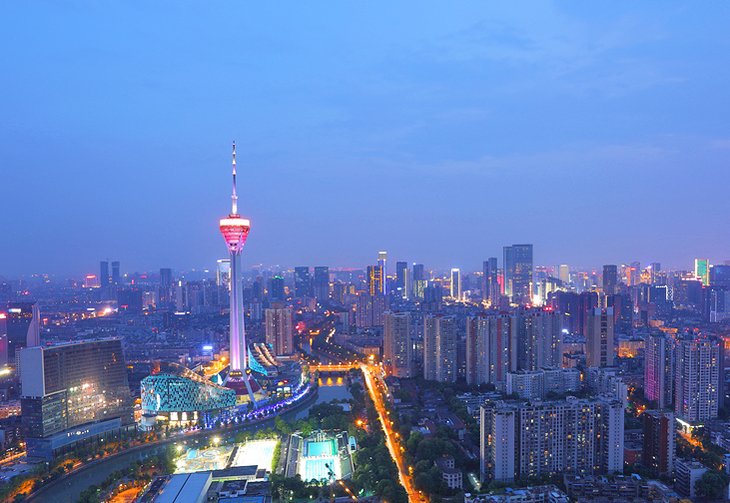
No Chinese city worth its salt has managed to go through the country's amazing expansion of the past several decades without having a towering tower added to its skyline. And Chengdu is no exception. Here, you'll discover the wonderfully built 339-meter-tall West Pearl Tower soaring out of the city's bustling business sector.
Located near to the Jinjiang River, the skyscraper seems like something out of a science fiction film. Since its construction in 2004, the tower has been a big tourist magnet, drawing constant crowds of travelers to enjoy not just the panoramic views from its observation deck, but also a meal in the city's highest restaurant (and yes, it rotates). The tower is the tallest structure in the city. An art gallery including displays of local artwork, photographs, and traditional Chinese calligraphy is one of the other highlights of the attraction.
21. Sanxingdui Museum and Jianchuan Museum Cluster
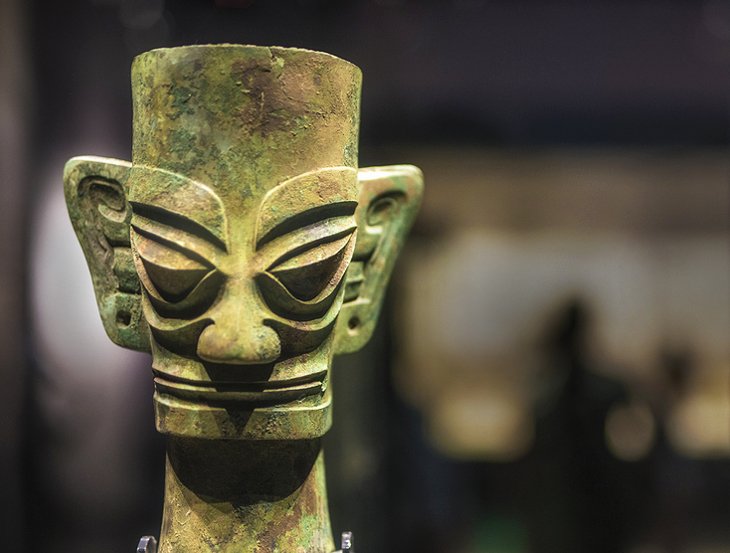
The Sanxingdui Museum is located close to Guanghan and is well worth the trip, despite the fact that it is slightly further north of Chengdu and takes significantly longer to get there using public transportation. Also known as the "Three-Star Piles Museum" after the ancient mounds found here, this enormous, contemporary institution is home to innumerable valuable relics excavated nearby that reflect the Sichuan area's rich cultural legacy, as well as the lives of the area's oldest human populations.
Many of the most significant artifacts, such as bronze artifacts (check out the museum's famous "bronze tree"), are housed in the museum's one-acre building. However, many larger relics and displays, such as the three mounds themselves (known to be part of an old wall), are dispersed across an area that is approximately 12 square kilometers in size and surrounds the museum.
If you're in the mood for some museum hopping, make a day of it by going to the interesting Jianchuan Museum Cluster in Anren Town. There, you'll be able to see a variety of museums under one roof. The cluster of notable museums is found within an hour's drive west of Chengdu. Together, these museums house the greatest private collections of antiquities and artifacts in the country (more than eight million at the most recent count). Items on display date from the Japanese invasion prior to WWII (the Communist Party Anti-Japanese Army Museum) through the plight of the country's POWs during this horrific struggle (The Unyielding POW Hall), which are fascinating, especially for military history buffs.

